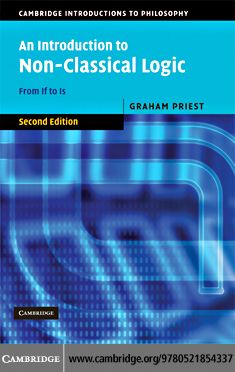An introduction to non-classical logic: From if to is
Graham Priest
Priest, Graham;
An introduction to non-classical logic: From if to is
Cambridge University Press, 2nd ed, 2008, 613 pages
ISBN 0521854334, 9780521854337
topics: | logic | philosophy | uncertainty
One motivation for non-classical logics is to handle the difficulties of boolean predicates.
Sorites paradox : The problem with T/F predicates
[etym: Sorites <-- gk soros σωρός = heap. pron. /səˈraɪtiːz/ sor-uy-tees]
If someone is a child, they are a child one second later. If Mary is a child on her fifth birthday, then she is also a child at the next second. Thus she keeps on being a child till she is 35.
vagueness requires us to reject a simple dichotomy between truth and falsity.
It is natural to suppose, therefore, that truth values must themselves
change continuously.
It arises because the predicate ‘is a child’ is vague in the sense that small changes to an object (in this case, a person) seem to have no effect on the applicability of the predicate. [p.221]
Many such predicates: * is tall * is drunk * is red * appears red * is a heap of sand (‘sorites’ comes from the Greek soros meaning ‘heap’). ‘is dead’ is a sorites - dying takes time: one nanosecond makes no difference. can be posed as a series of Modus Ponens inferences based on the universal of the form "Mary is a child after 1 second".
Responses to the Sorites paradox
consider the sequence: M0,M1, . . . ,Mk. M0 is definitely true; Mk is definitely false. what happens in between? If we suppose that every sentence is either simply true or simply false, and given that the change from child to adult is not reversible, then there must be a unique i such that Mi is true, and Mi+1 is false. But the discrete nature of the change (that is, the jump from truth to falsity) would seem to be incompatible with the relatively continuous nature of the change from being a child to being an adult. Some have bitten the bullet, and accepted that there is, indeed, such a point. The most notable defence of this line (given by epistemicists) attempts to argue that we find the existence of the point counterintuitive because, as a matter of principle, we cannot know where it is - because at that point, we would know Mi (Mi is true) but not Mi+1, which we cannot know since it is false. [sec. 11.3.3] But it is the very possibility of a cut-off point at all: the changes involved in one second of a person's life just do not seem to be of the kind that could ground a difference between childhood and adulthood.
Reject the simple dichotomy of T/F
section 11.3.6: Some philosophers have suggested that vagueness requires us to reject a simple dichotomy between truth and falsity. [But even 3-valued approaches will have] some i, such that Mi is true and Mi+1 is neither true nor false. --> counterintuitive. Any discrete shift will fail. It is natural to suppose, therefore, that truth values must themselves change continuously. --> fuzzy logic [FN: There are sorites progressions where each step is clearly discrete: for example, the addition of a single grain of sand. So, in principle, one could use a finitely-many valued logic for these. But the continuum-valued semantics is more general, and can be applied to all sorites paradoxes, giving, what is clearly desirable, a uniform account.]
amitabha mukerjee (mukerjee [at-symbol] gmail) 2013 Sep 12
